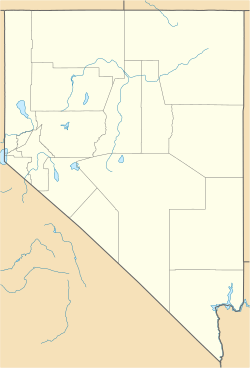Humboldt Cave facts for kids
Quick facts for kids |
|
|
Humboldt Cave
|
|
| Nearest city | Lovelock, Nevada |
|---|---|
| Area | 40 acres (16 ha) |
| NRHP reference No. | 76001140 |
| Added to NRHP | March 15, 1976 |
Humboldt Cave is an important old archaeological site in Churchill County, Nevada. It's a dry cave where scientists found many ancient items. These items were left behind by people who lived there long ago.
Scientists found 31 groups of hidden items, called "caches," inside the cave. A special test, called radiocarbon dating, showed that these items are about 2,000 years old. This suggests that the cave might have been used only once, or at least the items were all placed there around the same time.
What is Humboldt Cave Like?
Humboldt Cave is a very dry cave. This dryness helped to keep many old things safe from falling apart. When archaeologists first explored the cave in 1936, they found amazing artifacts. These included clothes made from animal skin and plant fibers, bags, and mats. Some items even showed that the people living here had connections with other groups in what is now Arizona and California.
The cave was formed by cracks in a cliff. Long ago, a large lake called Lake Lahontan would sometimes flood the cave. When the water dried up, it left behind a special rock called tufa on the cave walls. This tufa helped to protect the cave surfaces. Today, the remains of this ancient lake, now called Humboldt Sink, are about 220 feet (67 meters) below the cave and 6 miles (9.7 km) away.
The entrance to the cave is about 8 feet (2.4 meters) high and 6 feet (1.8 meters) wide. Inside, it gets a bit wider, about 8 feet (2.4 meters), and goes back about 49 feet (15 meters) deep. Besides humans, bats also lived in the cave. Their droppings, called guano, were 3 to 6 feet (0.9 to 1.8 meters) deep on the cave floor before it was dug up!
Exploring the Cave
Humboldt Cave was first dug up in 1936 by a scientist named Robert Heizer from the University of California, Berkeley. Heizer later wrote a book about his findings in 1956. He believed that because the cave was far from the lake and marsh areas, it was probably a temporary shelter, not a place where people lived all the time.
To start the dig, the scientists first made the cave opening wider so they could get in easier. They then measured the cave and divided it into 12 sections. Each section was about 3 feet (0.9 meters) wide. They dug down slowly, about 6 inches (15 cm) at a time.
Most of the items found were in great condition. Only things made of fur, feathers, bone, wood, and horn had been damaged by insects or small animals. In total, about 1,400 cubic feet (40 cubic meters) of dirt and items were removed from the cave. The scientists didn't find clear signs that people lived there at different times. Heizer thought the people who used Humboldt Cave might have been the same groups who lived in the upper levels of another nearby cave called Lovelock Cave.
Interestingly, pack rats also lived in Humboldt Cave. These rats would collect all sorts of things and fill up any empty spaces, including old artifacts. They especially liked a low, hollow area that the scientists called the "South Alcove." The pack rats mixed up many of the items. For example, during the dig, a wool sweater was left in the cave. The rats shredded it and carried pieces into the alcove. Later, parts of that same sweater were found all the way down to the solid cave floor!
Amazing Discoveries
The most important items found in Humboldt Cave were usually in one of 31 special "cache pits." These were holes dug into the cave floor by the people who lived there. The pits were lined with old baskets or grass.
One pit, called "shaman's cache" by the scientists, was very special. It held a robe made from bird skins, small bags, bones and skins of water birds, hawk feathers, and even a stuffed head of a canvasback duck. The birdskin robe probably had feathers on it originally, but insects had eaten most of them while it was buried. Heizer thought these items might have been used for healing or perhaps to make decoys for hunting.
Scientists also found several curved tools made from bighorn sheep horns. These tools looked like sickles, which are used for cutting grass.
Humboldt Cave was added to the National Register of Historic Places on March 16, 1976. It's important because it's a valuable prehistoric archaeological site. It also served as a place where students could learn about archaeology.
See also

- In Spanish: Cueva de Humboldt para niños



